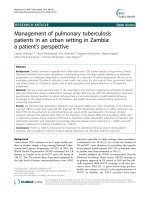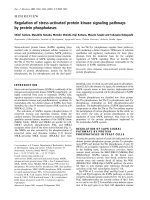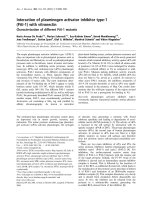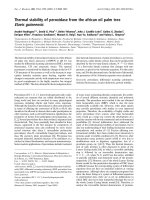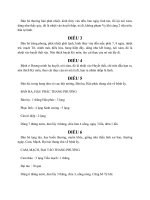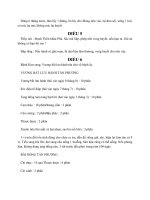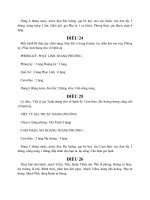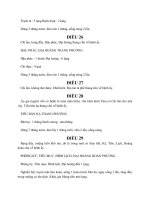Báo cáo y học: "Management of HBV Infection in Liver Transplantation Patients"
Bạn đang xem bản rút gọn của tài liệu. Xem và tải ngay bản đầy đủ của tài liệu tại đây (243.29 KB, 9 trang )
Int. J. Med. Sci. 2005 2(1)
41
International Journal of Medical Sciences
ISSN 1449-1907 www.medsci.org 2005 2(1):41-49
©2005 Ivyspring International Publisher. All rights reserved
Management of HBV Infection in Liver Transplantation
Patients
Review
Received: 2004.10.01
Accepted: 2005.01.01
Published:2005.01.05
John M. Vierling
David Geffen School of Medicine at University of California, Los Angeles, CA, USA
A
A
b
b
s
s
t
t
r
r
a
a
c
c
t
t
In the absence of preventative therapy, reinfection of allografts with hepatitis
B virus (HBV) after orthotopic liver transplantation (OLT) resulted in dismal
allograft and patient survival. Major advances in the management of HBV-
infected recipients of OLT during the past 15 years have steadily reduced the
rate of reinfection, resulting in improved outcomes. Initially, long-term use of
hepatitis B immune globulin (HBIG) as a source of anti-HBs antibodies was
effective in preventing or delaying reinfection. Lamivudine monotherapy
made it possible to suppress HBV replication prior to OLT, markedly
decreasing the risk of reinfection. Although lamivudine monotherapy used
before and after OLT could prevent reinfection, its effectiveness was limited
by progressive development of lamivudine-resistant mutant infections.
Combination therapy with HBIG and lamivudine after OLT reduced both
HBV recurrence and the risk of lamivudine resistance even in patients with
active HBV replication. Introduction of adefovir provided a safe, alternative
oral antiviral able to treat effectively lamivudine-resistant mutants HBV.
Available strategies to prevent reinfection have resulted in OLT outcomes for
HBV-infected patients comparable to those for patients transplanted for non-
HBV indications. In the future, combination therapies of HBIG and both
nucleoside and/or nucleotide agents will undoubtedly be optimized.
Development of new drugs to treat HBV will increase opportunities to
combine agents to enhance safety, efficacy and prevent emergence of HBV
escape mutants. New vaccines and adjuvants may make it possible to
generate anti-HBs in immunosuppressed patients, eliminating the need for
HBIG.
K
K
e
e
y
y
w
w
o
o
r
r
d
d
s
s
HBV Infection, Liver Transplantation, Patient Management
A
A
u
u
t
t
h
h
o
o
r
r
b
b
i
i
o
o
g
g
r
r
a
a
p
p
h
h
y
y
John M. Vierling is Professor of Medicine at the David Geffen School of Medicine at
UCLA. He is the former Director of Hepatology and Medical Director of Multi-Organ
Transplantation at Cedars-Sinai Medical Center. His basic and translational research interests
involve the immunological and inflammatory mechanisms of pathogenesis in alloimmune and
autoimmune liver diseases and viral hepatitis. He received his undergraduate degree in
Biology at Stanford University with great distinction and his M.D. degree from Stanford
University School of Medicine. He has served the American Association for the Study of
Liver Diseases as past Chairman of both the Training and Education and the
Publications Committees. He is also a past councilor of the International Liver
Transplantation Society, and selection by his peers as one of the Best Physicians in America.
He has served on the Editorial Boards of Gastroenterology, Hepatology and Liver
Transplantation. Prof. Vierling is a member of the Board of Directors of Ribapharm, Inc. and
the Scientific Advisory Boards of Immusol, Inc. and ICN Pharmaceuticals. He has been
active for many years in the American Liver Foundation and is the immediate past Chairman
of the National Board of Directors.
C
C
o
o
r
r
r
r
e
e
s
s
p
p
o
o
n
n
d
d
i
i
n
n
g
g
a
a
d
d
d
d
r
r
e
e
s
s
s
s
John M. Vierling, M.D., F.A.C.P.
Int. J. Med. Sci. 2005 2(1)
42
1. Introduction
Innovations in the management of HBV infection before and after orthotopic liver transplantation (OLT) have revolutionized
outcomes for hepatitis B virus (HBV)-infected recipients. In the absence of preventative therapies, OLT for patients with acute or
chronic replicating HBV infections resulted in universal reinfection of the allograft, progressive graft failure and excessive mortality,
even with retransplantation [1-3]. Thus, HBV-related liver disease was initially regarded as a contraindication to OLT [4] and was
excluded as an indication by Medicare in the U.S.A. [5]. Over the past 15 years, sequential application of therapeutic strategies to
prevent recurrent HBV infection after OLT and to inhibit HBV replication before and after OLT has steadily improved outcomes [6-
8]. Indefinite administration of passive immunoprophylaxis with hepatitis B immune globulin (HBIG, a source of high titer,
polyvalent anti-HBs antibodies) resulted in a significant reduction in recurrent hepatitis B, especially among recipients without
active HBV replication at the time of OLT [9-12]. Pre-OLT inhibition of HBV replication using lamivudine (LAM) rendered
patients with active replication eligible for transplantation, prevented recurrence post-OLT (unless LAM-resistant escape mutations
developed) and improved the outcome of patients who became reinfected [13-17]. The combination of HBIG and lamivudine
enhanced prevention of HBV reinfection [14,18], and the advent of adefovir dipoxil (ADV) provided an safe and efficacious
therapeutic option for patients with LAM-resistant infection [19]. As a result of this progress in prevention and treatment of HBV
reinfection, acute or chronic hepatitis B is now universally accepted as an excellent indication for OLT [8].
Transplantation of livers from donors with isolated anti-HBc-positivity (i.e. negative for HBsAg and anti-HBs) has resulted in
additional challenges, since isolated anti-HBc-positive livers are capable of transferring HBV infection to 50-78% of HBV-naïve
recipients in the absence of preventative therapy [20,21]. In addition, HBV-naïve recipients who have not been vaccinated to prevent
hepatitis B prior to OLT have an ongoing risk of acquiring parenterally transmitted HBV infections that require prompt diagnosis
and treatment [22-24]. Mandatory hepatitis B vaccination for all HBV-naïve patients with diseases that could require OLT could
significantly reduce this risk.
2. Impact of Strategies to Prevent and Treat HBV Infections in Transplant Recipients
A report of OLT outcomes for HBV-infected patients in the U.S.A. from 1987 to 2002 underscores the positive, cumulative
impact of advances to prevent and treat HBV reinfection [8]. This retrospective study analyzed cohorts of patients transplanted
during three eras: Era 1 (1987-91, n= 6,708), Era 2 (1992-96, n= 13,995) and Era 3 (1997-2002, n= 20,730). Survival of patients was
statistically significantly better for Era 2 compared with Era 1 (p<0.01) and Era 3 compared with Era 2 (p<0.01). No difference in
survival was noted for Era 3 patients and patients transplanted for all non-HBV indications. Importantly, multivariate analysis
showed that the effect of eras persisted even after consideration of confounding variables, such as donor and recipient age, ischemia
time, severity of pre-OLT disease and presence of hepatocellular carcinoma. In contrast to earlier reports, Asian race [25-27] did not
adversely affect survival and transplantation of patients with fulminant hepatitis B [9] did not enhance survival. The results of this
study and those reported from Europe [13,28], indicate that application of innovative strategies to prevent and treat HBV infections
before and after OLT are responsible for improved outcomes.
3. HBV Reinfection of Allografts
Two mechanisms have been implicated in allograft reinfection: 1) rapid reinfection by HBV in the circulation of the recipient
and/or 2) reinfection from HBV replicating in extrahepatic sites [29]. Since the former mechanism predominates in recipients with
high HBV viral loads at the time of OLT, patients with active replication detected by insensitive molecular hybridization assays
were considered as inferior candidates [9].
Among patients receiving immunoprophylactic HBIG, late reinfections were attributed to either insufficient serum levels of
anti-HBs to prevent infection from extrahepatic HBV [11,30] or emergence of anti-HBs escape mutations in the HBV S ORF
[31,32]. Subsequent experience using LAM [33,34] and ADV [35] as prophylactic therapies has also demonstrated reinfections due
to specific escape mutants. Thus, HBV-infected and HBV-naive recipients of livers from donors positive for isolated anti-HBc
remain at risk for reinfection unless adequate preventative therapy is maintained.
The impact of HBV genotype and precore mutants on reinfection has only recently been assessed. In London, genotypes A, D
and A/D accounted for 89% of the European population undergoing OLT. Reinfection occurred in 40% a median of 10 months post-
OLT, and 22% died [36]. The rate of reinfection was not significantly greater for genotype D than A, and the reinfection rate in
patients with genotype A/D was similar to genotype D patients. Among a heterogeneous population of recipients from the Middle
East, Eastern and Western Europe, the U.S.A. and Asia, genotype D was present in 96% and A in 4% [37]. Reinfection occurred in
22%, and no differences were noted among genotypes with respect to risk or prevalence of reinfection, development of LAM
resistance or prevalence of precore mutations.
4. Management of Patients Prior to Transplantation
Studies of HBIG monotherapy established active HBV replication before OLT as a dominant risk factor for reinfection [9,30].
Thus, therapies to reduce or eliminate HBV replication prior to OLT should result in a lower incidence of reinfection. The
characteristics of ideal antiviral agent(s) would include low toxicity in the setting of decompensated cirrhosis and the rapid ability to
eliminate HBV replication in patients with either acute or chronic infections. Despite clear progress in our ability to eliminate HBV
replication, additional advances in drug development and application of antiviral strategies is required to achieve this goal.
Alpha Interferon and Famciclovir
The need for an extended period of interferon (IFN) therapy prior to OLT limited its potential for patients with fulminant or
acute HBV infections, and its adverse effects, especially neutropenia and thrombocytopenia, resulted in poor tolerability in
decompensated cirrhotics [38]. In a controlled trial of pre-OLT IFN therapy followed by HBIG immunoprophylaxis, the rate of
reinfection was unchanged [39], while another study showed a reduced rate after IFN treatment [40]. In the same era, results of
treatment with famciclovir were disappointing [41]. Neither IFN nor famciclovir are currently indicated treatments.
Int. J. Med. Sci. 2005 2(1)
43
Lamivudine Monotherapy
LAM has been extensively studied in OLT candidates (Table 1), is well tolerated in decompensated cirrhosis and results in
undetectable HBV DNA using molecular hybridization in 63-100% of patients within 2-3 months [15, 42-52]. LAM is effective for
both wild type (WT) and precore mutant (HBeAg-negative) strains [51]. Uninterrupted therapy is required prior to OLT, since
premature cessation results in recurrent HBV replication [53]. Unfortunately, prolonged therapy, which is necessary for clinical
benefit, increases the risk of developing LAM-resistant mutations as a result of amino acid substitutions in the YMDD motif
encoded by the HBV RNA-dependent DNA polymerase gene [54]. The incidence of such mutations was 15-20% per year in the
studies summarized in Table 1, and development of mutations can worsen liver failure [52]. Results of OLT in patients with YMDD
mutations before transplantation have been reported for only a few patients and were conflicting [48,49,55,56]. Combination HBIG
and LAM prevented recurrence in some [55,56], but not all recipients [48,49]. Since ADV and tenofovir have excellent efficacy
against LAM-resistant HBV mutants [57,58], they should be used to treat patients with LAM resistance prior to OLT.
Table 1. Results of Lamivudine Monotherapy Prior to OLT (*Mean or Median. NR; not reported.)
The impact of lamivudine
therapy for 3 to 6 months prior to
OLT on hepatic function and
transplant-free survival have been
analyzed in several studies
[46,47,50,52,59,60]. In one study,
long-term treatment of
decompensated cirrhotics on the OLT
waiting list improved both hepatic
function and survival compared to
untreated, historical controls [47].
However, a retrospective analysis of
LAM treatment of 309 patients listed
for OLT showed no overall benefit in
mortality before OLT or duration of
transplant-free survival, except for
patients with milder disease [50]. The Child-Turcotte-Pugh (CTP) score was the only variable significantly associated with pre-OLT
death and prediction of OLT-free survival. In a prospective study of indefinite LAM pre-OLT therapy, 32 of 154 patients (21%) died
and 25 of the 32 deaths occurred within 6 months of initiating therapy [52]. Bilirubin, creatinine and detectable serum HBV DNA
were independent predictors of death within the 6 month period. In contrast, the estimated actuarial 3 yr survival for patients that
survived ≥ 6 mo on therapy was 88%. Since rates of virological response to LAM were similar for patients who died or survived,
both the initial and persistent severity of liver disease remain the best predictors of pre-OLT survival. Since liver allocation priority
increases with liver disease severity in the U.S.A., LAM therapy does not jeopardize access to a donated organ.
Adefovir Monotherapy
ADV is active against WT HBV, precore mutants and LAM-resistant strains [61]. In a study of 128 patients with
decompensated cirrhosis who had failed LAM therapy while awaiting OLT, ADV treatment for a median of 18 weeks reduced the
HBV DNA level by 2.2 log
10
by 4 week, by 4.1 log
10
after 24 weeks and improved the CTP score [62]. Patients with renal
dysfunction required ADV dose reductions. Although no patient developed ADV resistance in the study, ADV resistant mutants [63]
have been recently described in the post-OLT setting [35]. Neither the clinical nor virological impacts of ADV mutations have been
defined. As noted earlier, ADV is an excellent therapy for pre-OLT patients with LAM-resistant infections [19,62].
Tenofovir Monotherapy
Tenofovir disiproxil fumarate (TDF) is a nucleotide analogue that is FDA-approved for the treatment of HIV [64,65]. TDF also
potently inhibits replication of WT and LAM-resistant HBV in infected patients but is not FDA-approved for this indication
[58,66,67]. Since the antiviral effect of TDF is more rapid than that of ADV [68], it may be advantageous in patients with rapidly
progressive disease or in those predicted to have a very short waiting period prior to OLT. Controlled trials of the safety and efficacy
of TDF in pretransplant patients with WT and LAM-resistant infections should be performed.
Entecavir Monotherapy
Entecavir (ETV), a deoxyguanine nucleoside analogue, is a potent antiviral agent for both WT and LAM-resistant forms of
HBV [69] that reduces HBV DNA levels to a greater degree than LAM [70]. ETV is currently in phase III clinical trials in non-
transplant patients, and ETV-resistant mutations have been reported in 2 patients to date [71]. Its future role in the treatment of
pretransplant patients to eliminate HBV replication should be determined in future controlled trials.
5. Monotherapy to Prevent HBV Reinfection After Transplantation
Hepatitis B Immune Globulin Monotherapy
Long-term use of HBIG in the late 1980s in Europe and in the early 1990s in the U.S.A. significantly reduced the rate of
reinfection and improved both graft and patient survival [9-12]. Although mechanism(s) of action of passive immunoprophylaxis
with polyvalent anti-HBs antibodies remain unclear, the primary hypothesis is that anti-HBs bound to the surface of infectious HBV
prevents HBV-receptor-mediated uptake by hepatocytes. Thus, HBIG is administered first during the anahepatic phase of OLT and
subsequent dose regimens are designed to maintain an effective concentration of opsonizing anti-HBs. Immediately post-OLT, when
the amount of circulating HBV remains high, a target trough level of anti-HBs of 500 IU/L has been recommended [72]. Later, when
Authors N= Duration of
Therapy*
(months)
Negative HBV
DNA
(%)
Resistant
Mutants
(%)
Reference
Grellier, et al. 17 > 1 100 NR 42
Markowitz, et al. 10 2.7 100 NR 43
Villeneuve, et al. 35 19 100 25 44
Lo, et al. 31 3.2 63 NR 45
Perrillo, et al. 30 29 74 22 46
Yao, et al. 23 13 100 10 47
Seehofer, et al. 17 7.2 88 18 48
Rosenau, et al. 19 12 NR 10.5 49
Marzano, et al. 33 16 73 3 15
Fontana, et al. 162 16 67 11 50
Andreone, et al 25 4.5 92 8 51
Fontana, et al 154 5.7 >80 27 52
Int. J. Med. Sci. 2005 2(1)
44
extrahepatic sites of replication become the source of HBV, a lower trough level of 100-150 IU/L has been considered protective if
maintained indefinitely [7,72]. In the initial multicenter, European report, the rate of recurrent infection in patients receiving HBIG
was directly correlated with the amount of HBV replication prior to and after OLT, being least in patients transplanted with
fulminant hepatitis B (17%) and greatest in cirrhotics (67%) [9]. The rate of reinfection in patients receiving HBIG who were
transplanted with fulminant hepatitis delta virus (HDV) infection and HDV cirrhosis was 40% and 32%, respectively [9]. In patients
with active HBV replication pre-OLT, reinfection could be prevented by using higher doses of HBIG to maintain anti-HBs levels >
500 IU/L [10,11]. Overall, HBIG immunoprophylaxis reduced reinfection rates for cirrhotic patients to 16-35% in the presence of
replicating HBV pre-OLT and to 0-15% in the absence of replication [9,11,12,28]. In Europe, an intravenous formulation of HBIG
made infusion the preferred route [9]. Intramuscular formulations available in the U.S.A. [73] were most often infused, but
intramuscular injections were also effective [74,75]. The need to monitor trough anti-HBs levels can be overcome by using a fixed
dose of 10,000 IU once monthly [10]. However, monitoring of serum anti-HBs trough levels to define variability in immunoglobulin
catabolism permits individualized dosing and significant cost savings.
HBIG therapy is safe and most adverse events have primarily been ascribed to the intravenous administration of intramuscular
preparations [10,72]. A report of mercury toxicity in one patient has not been verified by others [76]. Unfortunately, the indefinite
administration of HBIG remains expensive, and repeated measurements of trough anti-HBs levels add to the costs.
Despite HBIG immunoprophylaxis, late reinfection occurs, especially in patients with active pre-OLT replication of HBV. Late
reinfections can be caused by failing to maintain adequate anti-HBs levels or by emergence of escape mutations, resulting selective
pressure of anti-HBs. The primary escape mutation is G145R in the small surface protein “a” determinant that conformationally
prevents anti-HBs binding [31,32,77]. Once HBIG is discontinued, WT HBV reemerges [31].
Lamivudine Monotherapy
The goal of LAM monotherapy after OLT is to prevent reinfection of the allograft by inhibiting HBV replication in
extrahepatic sites. Unfortunately, post-OLT monotherapy has been associated with reinfection with LAM-resistant YMDD mutants
in 23-50% of patients, with increased mortality in some [42,45,46,78,79]. Thus, LAM monotherapy for post-OLT prophylaxis has
been abandoned in favor of combination therapies.
6. Combination Therapies to Prevent HBV Reinfection After Transplantation
Hepatitis B Immune Globulin and Lamivudine
The combination of LAM therapy pre- and post-OLT with HBIG post-OLT has become the standard of care for most liver
transplant programs (Table 2). Multiple studies showed that the mean reinfection rate was only 5.2% (range 0-18%) after 1 to 2
years, [14,15,18,28,43,48,49,75,80,81]. Importantly, using highly sensitive PCR, circulating HBV DNA was undetectable in most
patients after OLT [7,28,82]. The mechanism(s) contributing to the efficacy of combination LAM and HBIG remain poorly defined.
Postulated mechanisms include the synergy of: 1) LAM reducing HBV replication and altering synthesis of HBsAg necessary for
generation of HBIG escape mutations and 2) HBIG preventing the receptor-mediated entry of HBV into hepatocytes and
extrahepatic cells required for production of escape mutations in the YMDD motif. In addition to efficacy, combination therapy is
more cost effective because the dosage of expensive HBIG can be reduced [14,49]. Combination therapy also permitted effective
conversion of a high dose intravenous HBIG regimen to a lower dose intramuscular regimen in 98% of patients [74]. A recent study
demonstrated efficacy and further cost reductions as a result of injecting HBIG only when anti-HBs levels fell below 70 IU/L [83].
Given differences in HBIG preparations and variations in their use, it is important to note that the optimal protocol for safety,
efficacy and cost of combination LAM and HBIG prophylaxis has not been defined.
Table 2. Effect of Combination Therapy with HBIG and Lamivudine to Prevent HBV Reinfection After OLT. (IV, intravenous; IM,
intramuscular, NR, not reported.)
Authors N= Pre-OLT
Duration* of
LAM
(mos)
HBV DNA
Negative at
OLT
(%)
HBIG
Route of
Administration
HBV
Reinfection
(%)
Reference
Markowitz, et al. 14 3 93 IV 0 43
Yao, et al. 10 8.6 80 IV then IM 10 75
Yoshida, et al. 7 NR 100 IM 0 80
Angus, et al. 37 3.2 NR IM 3 18
Marzano, et al. 33 4.6 100 IV 4 15
McCaughan, et al. 9 0 NR IM 0 81
Rosenau, et al. 21 4.6 77 IV 10 49
Roche, et al. 15 4.6 73 IV 7 28
Han, et al. 59 NR NR IV 0 14
Seehofer, et al. 17 10.6 71 IV 18 48
Development of LAM-resistant mutants during LAM monotherapy pre-OLT (Table 1) complicates analysis of the benefits of
combination LAM and HBIG therapy post-OLT, since most patients with LAM resistance pre-OLT have received LAM and HBIG
combination therapy after OLT (Tables 1 and 2). One such patient had not developed reinfection 32 months after OLT [56], while
two patients rapidly developed reinfection 13 and 75 days post operatively [84]. ADV treatment of 128 pre-OLT patients with LAM
resistance showed undetectable HBV DNA (<400 copies/ml) in 81% of those treated for 48 weeks, and 50-83% showed concurrent
improvement in liver tests [62]. These reports indicate that ADV should be used once LAM resistance is detected pre-OLT and that
combination ADV and HBIG be used after transplantation.
Int. J. Med. Sci. 2005 2(1)
45
Hepatitis B Immune Globulin and Ganciclovir
Intravenous ganciclovir failed to provide additional prophylaxis against HBV reinfection in patients receiving HBIG [85] and
should no longer be used.
Hepatitis B Immune Globulin and Adefovir
Controlled trials of this combination therapy have not been reported, but the lower incidence of escape mutations to ADV [35]
compared to LAM enhances the rationale for such studies.
7. Sequential and Modified Combination Therapies
To assess the reinfection rate among low risk patients receiving HBIG, patients were randomized to continue HBIG or to
discontinue it and begin LAM [86]. Low risk was defined as an absence of detectable HBV DNA at the time of OLT and absence of
reinfection for a minimum of 6 months post-OLT. After one year, reinfection occurred in 20% of patients in each group, but the
finding of circulating HBV DNA by PCR in 2 of 11 receiving HBIG and 5 of 10 receiving LAM suggests that reinfection would be
likely in additional patients with longer observation. Discontinuation of HBIG from a combination regimen of HBIG and LAM was
also studied in 14 randomly selected patients from a group of 29 who were HBV DNA negative at the time of OLT (17 induced by
LAM pre-OLT) and had received combination therapy for one month [87]. Although none of the patients developed clinical
reinfection during 18 months of observation, HBV DNA and polymerase mutations were detected in both groups. In a non-
randomized study, no reinfections were identified after 12 months in 16 patients who were treated with LAM monotherapy after
having received HBIG for 24 months [88]. Despite the advantages of ease of patient care and cost reduction, discontinuation of
HBIG remains risky because there are no definitive tests to identfy patients have cleared HBV from liver and plasma, and once
reinfection occurs, HBIG cannot be reinstituted. Indeed, HBV DNA has been detected in the liver, serum or leukocytes in 50% of
HBsAg-negative patients treated for 10 years with HBIG prophylaxis [28] and among patients treated with combination HBIG and
LAM [15,86].
8. Manipulation of the Immune Response
Adoptive Transfer of HBV Immunity from Donor Livers: Effective adoptive transfer of humoral immunity to hepatitis B
was first demonstrated in recipients of bone marrow transplants from immune donors [89,90]. Transplantation of livers from HBV
vaccinated woodchucks into HBV-infected recipients also has been shown to reduce or delay severity of reinfection, presumably due
to the effects of HBV-specific memory cells among passenger leukocytes [91]. An initially low recurrence rate in a Chinese cohort
receiving LAM monotherapy was hypothesized to be due to transplantation of passenger leukocytes in HBV-immune donors that
produced anti-HBs in the recipients [45]. A recent report ascribed the successful elimination of a de novo HBV infection post-OLT
with development of anti-HBs to the fact that the liver donor had been immunized against hepatitis B [92].
Vaccination After Transplantation: The prospect of generating active immunity against HBsAg epitopes remains an
intriguing strategy that could obviate the need for passive immunoprophylaxis. Following replacement of HBIG with HBV
vaccination, 14 of 17 responders (anti-HBs levels of 10-100 IU/L) did not develop reinfection after a median observation period of
14 months (range 3-50 months) [93]. In contrast, discontinuation of HBIG with triple course of vaccine produced detectable anti-
HBs levels in only 18% of recipients in another study [94]. HBV vaccination of pediatric patients post-OLT resulted in detectable
anti-HBs in 17 or 19 (89%) [95]. Among 9 patients who received livers from anti-HBc-positivie donors, anti-HBs developed in 7
and only 1 of the non-responders developed de novo HBV infection. New strategies to enhance immunogenicity of hepatitis B
vaccines in immunosuppressed patients post-OLT also have been reported. Repeated immunization of patients receiving HBIG who
were HBV DNA negative prior to OLT with multiple doses of recombinant HBV vaccine emulsified in novel adjuvants resulted in
substantial anti-HBs levels (range 721-83,121 IU/L) in 80% and permitted discontinuation of HBIG [96]. Although preliminary,
these results provide proof of principle that HBV vaccination can generate protective levels of anti-HBs in immunosuppressed
patients.
Immunosuppressive Regimen: The majority of studies of the prevention of HBV reinfection have been from centers using a
combination of steroids and either cyclosporine or tacrolimus as immunosuppression. Early steroid withdrawal has been considered
desirable because it limits the duration of stimulation of the glucocorticoid response element in the HBV genome [97]. Although
rapid withdrawal of steroids can be achieved [98], its impact on the incidence and timing of HBV reinfection has not been
systematically studied. The increasing use of nucleoside and nucleotide therapies to eliminate HBV replication prior to OLT and the
effectiveness of post-OLT preventative strategies despite immunosuppression argue against an urgent need for such studies.
9. Prevention of Transmission from Isolated Anti-HBc Positive Donor Livers
Because of the shortage of deceased donor organs, livers from isolated anti-HBc-positive donors (negative for HBsAg and anti-
HBs) are being routinely transplanted into HBV-naïve recipients [99]. In the absence of preventative measures, HBV infection
occurred in 50% to 78% of such recipients in Spain [20] and the U.S.A. [21] , respectively. However, livers from anti-HBc-positive
donors can be successfully used without reinfection if recipients receive prophylactic therapy with a combination of HBIG and LAM
[100,101] or LAM monotherapy [102]. Recent reports also indicate that anti-HBc positivity in the donor is not a contraindication for
live donor liver transplantation when effective prophylaxis is given [103,104].
10. Therapy for Established Reinfection After Transplantation
Lamivudine and Adefovir: As discussed above, the majority of hepatitis B OLT recipients are currently treated with LAM
preoperatively (Table 1) and a combination of HBIG and LAM postoperatively (Table 2). Prolonged therapy with LAM pre-OLT
results in a progressive risk of developing resistant YMDD mutants post-OLT [42,45,46,78,79]. The effectiveness of ADV treatment
of LAM-resistant mutations has been reported in patients with significant reinfections with YMDD mutants post-OLT [62,105].
Thus, ADV treatment should be started as soon as YMDD mutations are identified pre- or post-OLT. Since ADV resistance also has
been identified in an OLT recipient [35], serum HBV DNA should be serially monitored in patients treated long-term with ADV.
